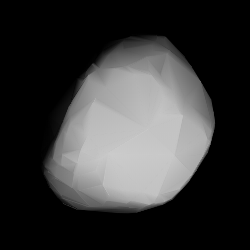Astronomy:4222 Nancita
 Shape model of Nancita from its lightcurve | |
| Discovery [1] | |
|---|---|
| Discovered by | E. Helin |
| Discovery site | Palomar Obs. |
| Discovery date | 13 March 1988 |
| Designations | |
| (4222) Nancita | |
| Named after | Nancy Coker Helin (discoverer's family)[2] |
| 1988 EK1 · 1950 TF4 1952 HN · 1968 QL1 1972 XQ1 · 1979 SL6 1983 XC1 · 1988 KL | |
| Minor planet category | Mars-crosser ex main-belt · (inner) |
| Orbital characteristics [1] | |
| Epoch 4 September 2017 (JD 2458000.5) | |
| Uncertainty parameter 0 | |
| Observation arc | 48.77 yr (17,813 days) |
| |{{{apsis}}}|helion}} | 3.0666 AU |
| |{{{apsis}}}|helion}} | 1.6705 AU |
| 2.3685 AU | |
| Eccentricity | 0.2947 |
| Orbital period | 3.65 yr (1,331 days) |
| Mean anomaly | 104.75° |
| Mean motion | 0° 16m 13.44s / day |
| Inclination | 3.7412° |
| Longitude of ascending node | 206.85° |
| 217.61° | |
| Mars MOID | 0.1710 AU |
| Physical characteristics | |
| Mean diameter | 8.47±0.8 km (IRAS:11)[3] 9.14±0.71 km[4] 9.636±0.121[5] 9.707±0.215 km[6] |
| Rotation period | 3.8732±0.0003 h[7] |
| Geometric albedo | 0.2057±0.0073[6] 0.209±0.013[5] 0.232±0.038[4] 0.2703±0.061 (IRAS:11)[3] |
| SMASS = S[1][8] | |
| Absolute magnitude (H) | 12.3[1] · 12.4[8][3][4][6] |
4222 Nancita (prov. designation: 1988 EK1) is a bright background asteroid and upcoming Mars-crosser on an eccentric orbit from the inner regions of the asteroid belt. It was discovered on 13 March 1988, by American astronomer Eleanor Helin at Palomar Observatory in California, United States.[9] The S-type asteroid has a rotation period of 3.9 hours and measures approximately 9 kilometers (5.6 miles) in diameter. It was named after the discoverer's daughter-in-law, Nancy Coker Helin.
Orbit and classification
Nancita is a non-family asteroid from the main belt's background population when applying the hierarchical clustering method to its proper orbital elements. It will become a Mars-crossing asteroid in June 2019. It orbits the Sun in the inner main-belt at a distance of 1.7–3.1 AU once every 3 years and 8 months (1,331 days). Its orbit has an eccentricity of 0.29 and an inclination of 4° with respect to the ecliptic.[1] The asteroid was first observed as 1950 TF4 at McDonald Observatory in 1950. Its observation arc begins at Crimea–Nauchnij in 1968, when it observed as 1968 QL1, or 20 years prior to its official discovery observation at Palomar.[9]
Naming
This minor planet was named in honor of Nancy Coker Helin, daughter-in-law of the discoverer, and wife to Bruce Helin, after whom the minor planet 2430 Bruce Helin had previously been named. Nancy is described by the discoverer as a talented singer, composer and teacher, who has brought music and joy to her family.[2] The official naming citation was published by the Minor Planet Center on 2 December 1990 (M.P.C. 17466).[10]
Physical characteristics
In the SMASS classification, Nancita is a common S-type asteroid.[1]
Rotation and shape
A rotational lightcurve of Nancita, obtained from photometric observations at the Australian Hunters Hill Observatory (E14) and collaborating stations in 2006, gave a well-defined rotation period of 3.8732 hours with a high brightness amplitude of 0.97 in magnitude ({{{1}}}), indicating that the body has a non-spheroidal shape.[7]
Diameter and albedo
According to the surveys carried out by the Infrared Astronomical Satellite IRAS, the Japanese Akari satellite, and the NEOWISE mission of NASA's Wide-field Infrared Survey Explorer, Nancita measures between 8.5 and 9.7 kilometers in diameter and its surface has an albedo in the range of 0.21 to 0.27.[3][4][5][6] The Collaborative Asteroid Lightcurve Link agrees with the results obtained by IRAS.[8]
References
- ↑ 1.0 1.1 1.2 1.3 1.4 1.5 "JPL Small-Body Database Browser: 4222 Nancita (1988 EK1)". Jet Propulsion Laboratory. https://ssd.jpl.nasa.gov/sbdb.cgi?sstr=2004222.
- ↑ 2.0 2.1 Schmadel, Lutz D. (2007). "(4222) Nancita". Dictionary of Minor Planet Names – (4222) Nancita. Springer Berlin Heidelberg. p. 361. doi:10.1007/978-3-540-29925-7_4187. ISBN 978-3-540-00238-3.
- ↑ 3.0 3.1 3.2 3.3 Tedesco, E. F.; Noah, P. V.; Noah, M.; Price, S. D. (October 2004). "IRAS Minor Planet Survey V6.0". NASA Planetary Data System 12: IRAS-A-FPA-3-RDR-IMPS-V6.0. Bibcode: 2004PDSS...12.....T. https://sbnarchive.psi.edu/pds3/iras/IRAS_A_FPA_3_RDR_IMPS_V6_0/data/diamalb.tab. Retrieved 16 March 2020.
- ↑ 4.0 4.1 4.2 4.3 Usui, Fumihiko; Kuroda, Daisuke; Müller, Thomas G.; Hasegawa, Sunao; Ishiguro, Masateru; Ootsubo, Takafumi et al. (October 2011). "Asteroid Catalog Using Akari: AKARI/IRC Mid-Infrared Asteroid Survey". Publications of the Astronomical Society of Japan 63 (5): 1117–1138. doi:10.1093/pasj/63.5.1117. Bibcode: 2011PASJ...63.1117U. (online, AcuA catalog p. 153)
- ↑ 5.0 5.1 5.2 Masiero, Joseph R.; Mainzer, A. K.; Grav, T.; Bauer, J. M.; Cutri, R. M.; Dailey, J. et al. (November 2011). "Main Belt Asteroids with WISE/NEOWISE. I. Preliminary Albedos and Diameters". The Astrophysical Journal 741 (2): 20. doi:10.1088/0004-637X/741/2/68. Bibcode: 2011ApJ...741...68M. http://adsabs.harvard.edu/cgi-bin/bib_query?bibcode=2011ApJ...741...68M. Retrieved 5 December 2016.
- ↑ 6.0 6.1 6.2 6.3 Mainzer, A.; Grav, T.; Masiero, J.; Hand, E.; Bauer, J.; Tholen, D. et al. (November 2011). "NEOWISE Studies of Spectrophotometrically Classified Asteroids: Preliminary Results". The Astrophysical Journal 741 (2): 25. doi:10.1088/0004-637X/741/2/90. Bibcode: 2011ApJ...741...90M. http://adsabs.harvard.edu/cgi-bin/bib_query?bibcode=2011ApJ...741...90M. Retrieved 2 May 2016.
- ↑ 7.0 7.1 Higgins, David; Pravec, Petr; Kusnirak, Peter; Reddy, Vishnu; Dyvig, Ron (September 2006). "Asteroid lightcurve analysis at Hunters Hill Observatory and collaborating stations - summer 2005/6". Minor Planet Bulletin 33 (3): 64–66. ISSN 1052-8091. Bibcode: 2006MPBu...33...64H. http://www.minorplanet.info/MPB/issues/MPB_33-3.pdf. Retrieved 19 March 2020.
- ↑ 8.0 8.1 8.2 "LCDB Data for (4222) Nancita". Asteroid Lightcurve Database (LCDB). http://www.minorplanet.info/PHP/generateOneAsteroidInfo.php?AstInfo=4222%7CNancita.
- ↑ 9.0 9.1 "4222 Nancita (1988 EK1)". Minor Planet Center. https://www.minorplanetcenter.net/db_search/show_object?object_id=4222.
- ↑ "MPC/MPO/MPS Archive". Minor Planet Center. https://www.minorplanetcenter.net/iau/ECS/MPCArchive/MPCArchive_TBL.html.
External links
- Lightcurve Database Query (LCDB), at www.minorplanet.info
- Dictionary of Minor Planet Names, Google books
- Asteroids and comets rotation curves, CdR – Geneva Observatory, Raoul Behrend
- Discovery Circumstances: Numbered Minor Planets (1)-(5000) – Minor Planet Center
- 4222 Nancita at AstDyS-2, Asteroids—Dynamic Site
- 4222 Nancita at the JPL Small-Body Database
 |

